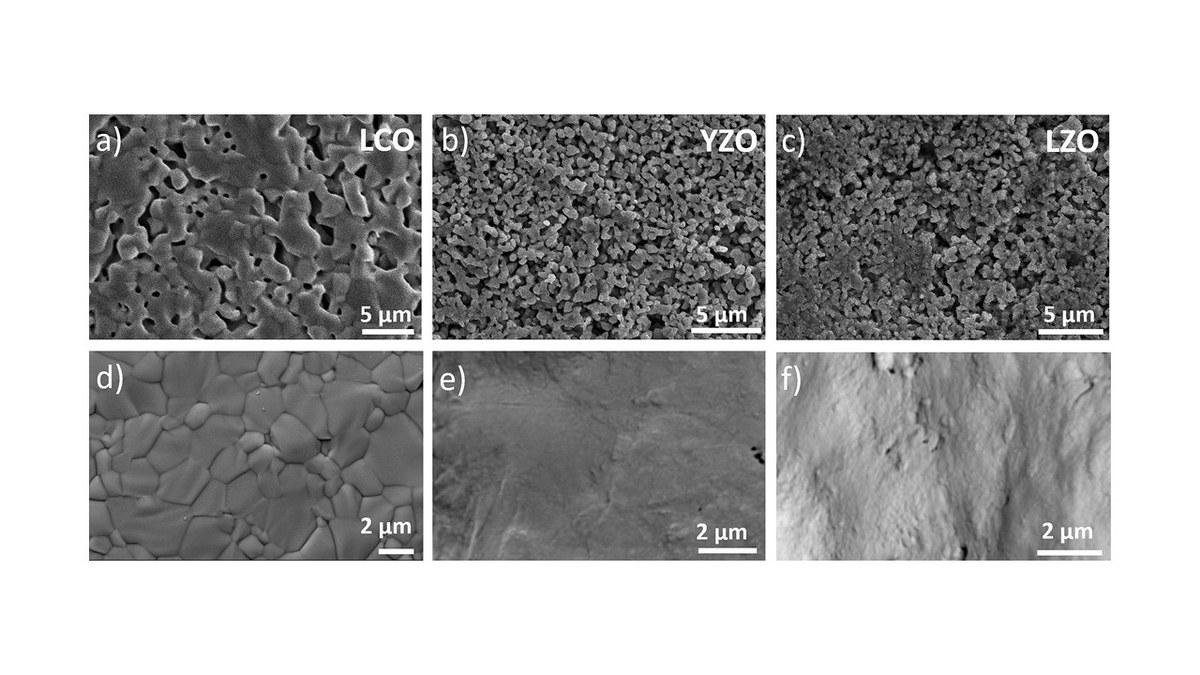Highly Doped Cerium and Zirconium Dioxide at Room Temperature – Progress for Future Energy Storage and Chemotronics
Cerium and zirconium dioxide with high acceptor doping can efficiently transport charge even at low temperatures, a key discovery for future miniature energy storage devices.

01 October 2025 – Researchers at Helmholtz Institute Münster (HI MS) of Forschungszentrum Jülich, in a joint project with partners from RWTH Aachen University and the Weizmann Institute of Science, have gained detailed insights into charge transport in highly acceptor-doped cerium and zirconium dioxide materials at room temperature for the first time.
These materials, previously known primarily for applications at temperatures above 500 °C, also exhibit ionic conductivity at room temperature on a scale that cannot be ignored, thus opening up new perspectives for use in solid-state chemotronics and on-chip microbatteries.
Precise Characterisation of the Structures
The study focused on the compounds lanthanum(III)-cerium(IV) oxide (La₂Ce₂O₇), yttrium(III)-zirconium(IV) oxide (Y₂Zr₂O₇) and lanthanum(III)-zirconium(IV) oxide (La₂Zr₂O₇), whose structures have been described in the literature in a somewhat contradictory manner to date. Using a combination of X-ray diffraction (XRD), Raman spectroscopy and X-ray pair distribution function (PDF), the team succeeded in precisely characterising the structures. Lanthanum(III)-cerium(IV) oxide in particular proved to be an exciting special case: a defective fluorite structure with local pyrochlore clusters.
Since the electrical conductivity of these ceramics is extremely low at room temperature, investigation using classical methods such as electrochemical impedance spectroscopy was only possible to a limited extent. The team therefore relied on scanning Kelvin probe force microscopy (KPFM) combined with local polarisation relaxation measurements.
This method made it possible for the first time to determine diffusion coefficients in both dry and humid atmospheres and showed that air humidity has a decisive influence on charge transport.
Innovative Mini Energy Storage Devices
The results point the way to novel, miniaturised energy storage and sensor solutions using protons as charge carriers, which can be integrated directly into silicon microfabrication. Due to their compatibility with sputtering techniques, the materials investigated offer attractive prospects for the further development of energy-efficient, solid-state-based components.
International Cooperation
The project was developed as part of the DFG-funded project “Proton conductivity at room temperature in hydrated pyrochlore materials” (funding code 523164409) in collaboration with Prof. Dr Roger De Souza (RWTH Aachen University) and Prof. Dr Igor Lubomirsky (Weizmann Institute of Science, Israel). Researchers from the University of Münster (Institute of Inorganic and Analytical Chemistry and MEET Battery Research Center) were also involved.
The researchers published the detailed results of their study as an open access article in the journal “Solid State Ionics”.
Researchers involved:
- Patrick Mowe, Helmholtz Institute Münster (HI MS) of Forschungszentrum Jülich
- Felix Pfeiffer, Helmholtz Institute Münster
- Oliver Maus, Institute of Inorganic and Analytical Chemistry at the University of Münster
- Prof. Dr Wolfgang Zeier, Helmholtz Institute Münster and University of Münster
- Prof. Dr Martin Winter, Helmholtz Institute Münster and MEET Battery Research Center at the University of Münster
- Dr Kerstin Neuhaus, Helmholtz Institute Münster
